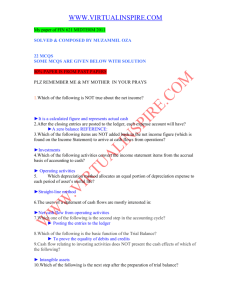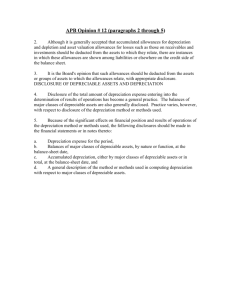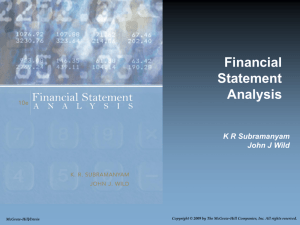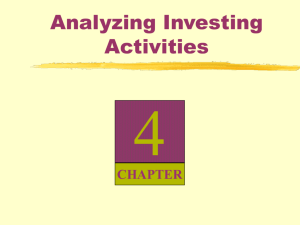STUDY SESSION 9 FINANCIAL STATEMENT ANALYSIS
advertisement
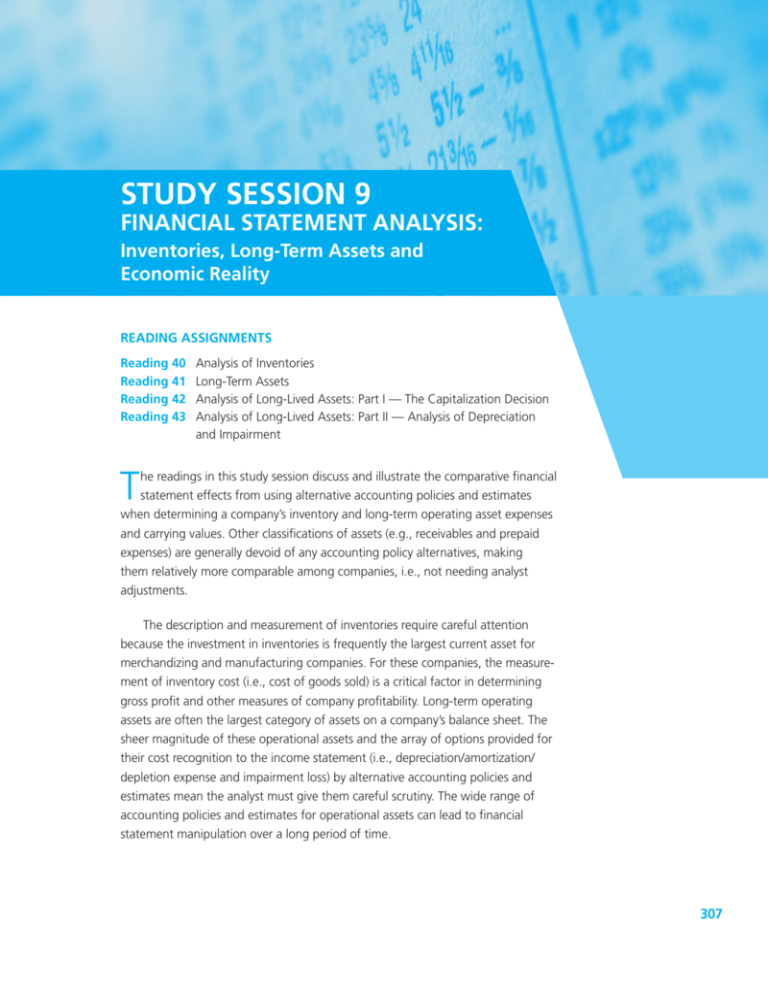
STUDY SESSION 9 FINANCIAL STATEMENT ANALYSIS: Inventories, Long-Term Assets and Economic Reality READING ASSIGNMENTS Reading 40 Reading 41 Reading 42 Reading 43 Analysis of Inventories Long-Term Assets Analysis of Long-Lived Assets: Part I — The Capitalization Decision Analysis of Long-Lived Assets: Part II — Analysis of Depreciation and Impairment T he readings in this study session discuss and illustrate the comparative financial statement effects from using alternative accounting policies and estimates when determining a company’s inventory and long-term operating asset expenses and carrying values. Other classifications of assets (e.g., receivables and prepaid expenses) are generally devoid of any accounting policy alternatives, making them relatively more comparable among companies, i.e., not needing analyst adjustments. The description and measurement of inventories require careful attention because the investment in inventories is frequently the largest current asset for merchandizing and manufacturing companies. For these companies, the measurement of inventory cost (i.e., cost of goods sold) is a critical factor in determining gross profit and other measures of company profitability. Long-term operating assets are often the largest category of assets on a company’s balance sheet. The sheer magnitude of these operational assets and the array of options provided for their cost recognition to the income statement (i.e., depreciation/amortization/ depletion expense and impairment loss) by alternative accounting policies and estimates mean the analyst must give them careful scrutiny. The wide range of accounting policies and estimates for operational assets can lead to financial statement manipulation over a long period of time. 307 308 Study Session 9 LEARNING OUTCOMES Reading 40: Analysis of Inventories The candidate should be able to: a. compute ending inventory balances and cost of goods sold using the LIFO, FIFO, and average cost methods to account for product inventory and explain the relationship among and the usefulness of inventory and cost of goods sold data provided by the LIFO, FIFO, and average cost methods when prices are 1) stable or 2) changing; b. analyze the financial statements of companies using different inventory accounting methods to compare and describe the effect of the different methods on cost of goods sold and inventory balances, discuss how a company’s choice of inventory accounting method affects other financial items such as income, cash flow, and working capital, and compute and describe the effects of the choice of inventory method on profitability, liquidity, activity, and solvency ratios; c. discuss the reasons that a LIFO reserve might decline during a given period and discuss the implications of such a decline for financial analysis; d. discuss how inventories are reported in the financial statements and how the lower of cost or market principle is used and applied. Reading 41: Long-Term Assets The candidate should be able to: a. describe the factors that distinguish long-term assets from other assets and identify the common types of long-term assets and how carrying value is determined on the balance sheet; b. determine the costs that are capitalized to property, plant and equipment and determine which costs are expensed as incurred; c. explain depreciation accounting (including the reasons for depreciation), calculate depreciation using the straight-line, production (also known as units-ofproduction), and declining-balance methods, and calculate depreciation after revising the estimated useful life of an asset; d. describe how to account for the sale, exchange, or disposal of depreciable assets, and determine whether a gain or loss is recorded; e. identify assets that should be classified as natural resources, determine their carrying values on the balance sheet and calculate depletion; f. identify the types of intangible assets and describe how the accounting treatment for goodwill under U.S. GAAP differs from the accounting treatment for other intangible assets. Reading 42: Analysis of Long-Lived Assets: Part I — The Capitalization Decision The candidate should be able to: a. compute and describe the effects of capitalizing versus expensing on net income, shareholders’ equity, cash flow from operations, and financial ratios including the effect on the interest coverage ratio (times interest earned) of capitalizing interest costs; Study Session 9 b. explain the circumstances in which intangible assets, including software development costs and research and development costs are capitalized; c. calculate and describe both the initial and long-term effects of asset revaluations on financial ratios. Reading 43: Analysis of Long-Lived Assets: Part II — Analysis of Depreciation and Impairment The candidate should be able to: a. identify the different depreciation methods and discuss how the choice of depreciation method affects a company’s financial statements, ratios, and taxes; b. explain the role of depreciable lives and salvage values in the computation of depreciation expenses, and compute and describe how changing depreciation methods or changing the estimated useful life or salvage value of an asset affects financial statements and ratios; c. discuss the use of fixed asset disclosures to compare companies’ average age of depreciable assets, and calculate, using such disclosures, the average age and average depreciable life of fixed assets; d. define impairment of long-lived assets and explain what effect such impairment has on a company’s financial statements and ratios; e. discuss the liability for closure, removal, and environmental effects of long-lived operating assets, and discuss the financial statement impact and ratio effects of that liability. 309




